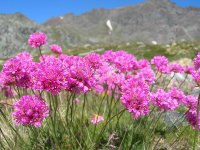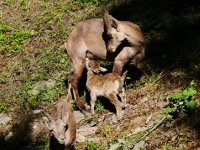Flora
A wealth of wildlife and plantlife thanks to biodiversity and environmental protection

The plantlife in the Val d'Aosta can boast as many as 2000 different species (from a total of 5600 varieties catalogued as the entire Italian flora).
The hilly areas upto a height of 800 m, are home to fruit trees and vineyards as well as oak and chestnut woods.
Along the Dora Baltea, there are also cane thickets, alders, polars and willows.
The tree vegetation - broad-leaved at lower levels - gradually evolves as you go higher up, firstly with a variety of birch and maple trees, then with populations of spiny-leaved trees; these include, up to a height of 2000 m, the rare and treasured Swiss stone pine with its long needles in groups of 5. Among the conifers there is the mountain and wood pine, white spruce, with its erect cones and white ash-coloured bark and the red spruce with its hanging cones. The highest of all is the larch, which, in autumn , turns a characteristic golden-yellow colour. In the regional park of Mont Avic the commonest tree is the Pinus uncinata, a type of Mugo Pine.
You can enjoy a particularly rich variety of plantlife on the grassy terraces at the end of June, when the Alpine flowers bloom: you can see the edelweiss, a protected plant species, and asters. On the morains you can find a variety of rocky flora, with types of heather and dwarf juniper. The various species of Glacier wormwood (Artemisia) also worth mentioning. These are gathered to make Génépy, a well-known liqueur from Val d'Aosta.
In the area around Perloz you can also find the "Peonia officinalis". Typical wetlands flora can be seen in the lake basins and also in the peaty / marshy areas found in the various nature reserves
Fauna
A highly-varied type of environment which is home to numerous species of wildlife

The ibex lives alone at very high altitudes and, thanks to its extraordinary agility, can exploit any patch of greenery it might find even onthe most impervious rocky mountain ridges. The Chamois lives in the same environment.
An extremely rare example of albino ibex was found on the slopes of Monte Emilius in 2007.
In recent decades, the population of deer has risen steadily, helped by the existence , in the valley, of large areas of woodland; there are also significant numbers of Roe Deer.
Occasional sightings have been made recently of the Lynx ; one hopes that this animal may make a decisive and permanent return.
The Fox, on the other hand, is extremely widespread in all environments and altitudes. The Marmot and the Mountain Hare are, among the animals found at high altitude, the most emblematic of the small mammals; although they are difficult to catch sight of, there are also Ermines, whose coat in winter turns white camouflage, and also the small Weasel, Beech Marten, Pine Marten and Badger.
The most important bird species include the Blackgrouse and the Golden Eagle, as well as another great predator, the Lammergeyer, which was only recently re-introduced after over 70 years of total absence from the Alpine populations.










